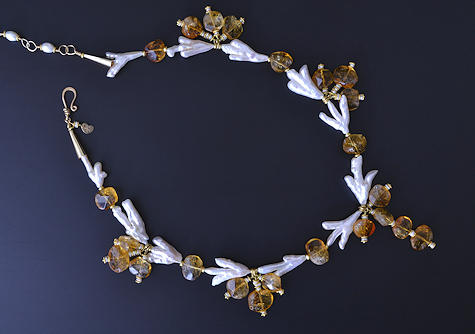Sculptural white branch pearls with faceted golden honey Citrines, what could be more lovely?
These pearls are likely Chinese, but there are many American freshwater pearls as well. The health of the industry depends on a clean, healthy ecosystem. Through history we have repeatedly decimated bivalve populations in our lust for pearls and in our disregard for environmental protection and water quality. Aaron Hirsh's troubling and yet inspiring book (below) describes how the Sea of Cortez pearl industry crashed into extinction in the 1930s. I remember camping on a beach in Baja sometime in the '60s and being offered perlas by a fisherman in a rickety little rowboat. Having heard of the legendary pearl beds and their destruction in biology classes, I was very interested to see them. It turned out his meager stash of perlas were actually polished scraps of abalone. I would still have one of those little perlas were it not for the fire.
As with every living thing, freshwater pearl mussels have complicated, interdependent relationships with other creatures. Their reproductive cycle includes a "glochidia" stage, specialized larvae which must attach to a fish before metamorphosis. Some species are dependent upon a single species of fish, others can attach to a wider variety. This is an obligate stage which means if the fish disappears, the mussels can't reach adulthood and so go extinct. The larvae don't harm the fish but use them as a safe place for a stage in their development and also to disperse the baby mussels. When we hear anti-environmentalists complaining about laws which protect some stupid fish, spouting some false dilemma like "fish or jobs," it might be wise to remember our pearl mussels and to realize that the web of life is intricate and interdependent in ways we can barely imagine and rarely understand until it is too late.
Speaking of Citrines, I want to call your attention to Lawrence Stoller's book (below). He is famous for cutting and polishing huge crystals and designing fabulous mountings for them. He came to wide public attention for his American Express Eleven Tears Memorial. In addition to being gorgeous, which is all I hoped for from his book, it is thoughtful and beautifully written. In his last chapter entitled "Mineralogy Meets Metaphysics" he gives anecdotes about Citrine. In one story which I've abbreviated he says, "Lying on the couch, I'm feeling tired... I pick up a citrine crystal, an old friend, and lay its cold body on my chest... We form an alliance. Within minutes, the crystal has warmed to my body temperature and the dis-ease that pervaded my body has vanished... The crystal doesn't change: I do." You might like the book. And you might like this necklace as well. Won't you order the set and perhaps contemplate Citrine energy and its relation to the life cycle of mussels?







